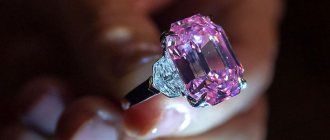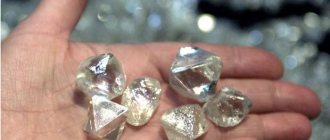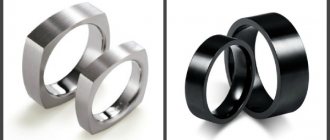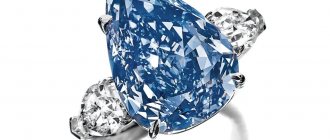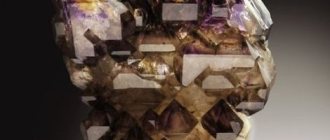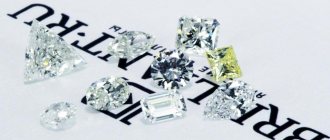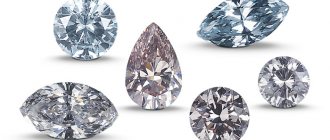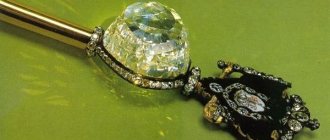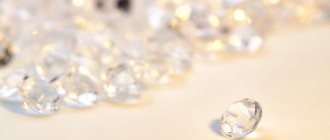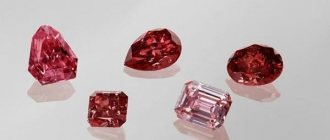A rough diamond is a hard mineral of natural origin, without cutting or polishing, unsightly in appearance and with a complete lack of shine. Only complete and careful diamond processing makes it an expensive diamond. The answer to the question: how and with what are diamonds processed will help you understand the reason for the high cost of crystals.
About the characteristics
The appearance of the stones depends on the order in which the atoms are built, the crystal lattice of which looks like a cube with four carbon atoms in the central part and one at each vertex. Rough diamonds are very durable, which is due to their specific structure. In addition to pure carbon, the composition may contain iron, magnesium, and calcium in small quantities.
Uncut diamonds vary in:
- density;
- blossom;
- purpose - technical and jewelry;
- physical and chemical properties;
- sizes , depending on weight - they are small, large, medium.
An uncut, rough diamond has various shapes, but most often looks like an octahedron, cube, dodecahedron, including rhombic. There are cubic specimens, among which rarely come across those of jewelry interest. Some mined diamonds even resemble shapeless blocks.
The color range of the stone is varied. Mostly colorless and yellowish minerals are found, occasionally red, pinkish, brownish, grayish, blue, black and even blue. Green specimens are rarely found in nature. The difference between crystals and each other is not only the color or shape, but also the degree of transparency.
The shades depend on what inclusions and impurities the stone contains, what it received under natural conditions of radiation exposure and structural features. Most minerals are unevenly colored, for example, one layer of color or several shades.
The hardness of diamonds received the highest, ten-point rating on the Mohs scale after comparison with other minerals. Their name translated from Greek means “invulnerable.” The rulers of Ancient Greece considered stones a symbol of power.
Difficulties of cutting
It is worth noting that cutting a diamond is not only a complex, but also a very long process. Large stones can be processed for several months, while unique ones can take several years. During these operations, the weight of the diamond can be reduced by three or two times, but the cost of the stone itself increases much more.
Therefore, jewelers must be not only good craftsmen, but also excellent mathematicians. Before processing begins, the future shape of the diamond is carefully calculated with the condition of maximum light transmission and preservation of the greatest mass. However, if previously jewelers had to do everything manually, now they are greatly helped by computers that allow them to automate this process.
Features of stones
Each pebble has its own characteristics, called “inclusions”. It is they who give it uniqueness and difference from its peers.
Inclusion is considered:
- the presence of voids inside;
- inclusions of foreign substances;
- cracks.
Many people are interested in the question of how diamonds are processed. The stones are so strong that they can only be cut using the same stones. Diamond is called the hardest, but at the same time fragile mineral of natural origin. It breaks easily when dropped. It can be set on fire using an ordinary magnifying glass. The combustion temperature is 700°C and above.
Strong acids are not capable of harming the mineral and deteriorating its appearance, structure, or color. Soda and saltpeter, or more precisely, their alkaline solutions, have an oxidizing effect on diamonds.
The gem has luminescent properties, which turns it into an indicator that determines the presence of radioactive particles. Their presence is indicated by electrical impulses and light flashes.
A little about mining
Diamonds are mined in Russia, Congo, South Africa, and Namibia. There are small deposits in Canada, Australia, Angola, and Botswana. Diamond mining is an expensive and labor-intensive process. Until the middle of the last century, the place to search for gems was mainly secondary deposits, the formation of which occurred as a result of the destruction of rocks. The process looked like gold mining: sand from the river was placed in a sieve using shovels and sifted, and then washed.
The largest reserves of future diamonds lie in primary rocks called “kimberlite pipes.”
Preparation for production is carried out in two stages:
- Formation of a 600-meter deepening using explosives.
- Laying mines.
Ore mined from the depths of the earth is delivered to factories for grinding and washing. To obtain one carat of crystals, sometimes it is necessary to process up to hundreds of tons of rock. Then culling takes place to select a certain type of diamond using water and X-rays, after which the stones are handed over to the cutters.
Quality and shape
According to statistics, only 20-25% of the raw materials mined in the world are used by jewelers. Only high-quality rough diamonds with impeccable color and clarity become part of precious jewelry.
Crystals with obvious defects, inclusions or foreign impurities are considered “technical”. Pebbles of poor quality and ugly color are needed in industry. In the same category there are gems of irregular shapes and too small sizes. They are used to make diamond dust, that is, they are crushed.
It is known that a diamond is a processed diamond. Its final form depends on the natural one acquired in nature. Uncut diamonds look dull and unattractive. The cutting process makes it sparkling, smooth, and expensive. Read more about the difference between a diamond and a diamond →
Without processing, the mineral is not particularly valuable, and they ask for no more than a hundred dollars. But a diamond made from diamond costs 4-10 times more.
The cost is also affected by the type of cut, which can be:
- round;
- fantasy.
Before processing, an oblong diamond takes on shapes called:
- marquis;
- drop/pear;
- oval;
- heart.
Stones, whose natural appearance had almost ideal outlines, receive one of the following forms:
- emerald;
- usher;
- radiant;
- princess.
Processing diamonds into round brilliants is a labor-intensive process that requires strict adherence to proportions. This causes the high cost of the round product. Learn more about how many facets a diamond has →
Cutting.
Cutting is an important step in diamond processing. This process involves cutting off the facets that form the final shape of the diamond.
The number, shape and arrangement of facets determine the type of cut. For example, a round cut must have a certain number of facets, with a designated shape and arrangement that strictly complies with standards and recommendations.
Faceting is important because the shape and arrangement of the edges ultimately affects the ability to reflect and refract incoming light.
That is, how much light will pass deep into the stone and how much can be reflected on the surface of the top or on another section of the stone.
This is extremely important for the quality of the stone because the more light that returns to the surface, the brighter and more brilliant the diamond will be. Disproportional, asymmetrical, and irregularly shaped facets will result in a low grade diamond that will be dark and dull.
However, there are types of cuts that are not designed to maximize brilliance; they are interesting for their shape and parallel edges. For example, the emerald cut is also quite popular, although such a diamond is not distinguished by the brightness of its brilliance due to the peculiarities of its structure.
How diamonds become diamonds
The gems to be processed must initially be of good size. The future diamond, that is, an uncut diamond, weighs 40-60% more than after finishing work on its creation.
People learned to work with precious stones long ago, but the stubborn crystal succumbed to them only in the 15th century. Diamond processing has always been a painstaking task, requiring several stages, during which numerous methods of work were tried.
Diamond uncut:
- polished by rubbing one stone against another;
- hammered into crumbs used to coat metal discs;
- sawed;
- acquired edges and planes in a certain quantity.
From diamond to diamond. About the history of cutting.
People learned to process gems thousands of years ago, but the rich history of the most amazing precious stone on Earth - the diamond - began relatively late. The main reason for this is its extraordinary hardness. Until the beginning of the 15th century, it was not possible to cut diamonds.
All that the masters who lived more than six hundred years ago could do with the indestructible stone was only to polish the natural edges of its crystals. To do this, one diamond was simply rubbed against another. But there was another method, which Indian jewelers were the first to use. Diamond crystal is durable, but not indefinitely. Using a hammer and anvil, diamond powder was obtained, then applied to a rotating metal disk. Thus, large crystals were polished using tiny diamond fragments.
Stones polished in this way were called “diamond tips” or “pointed”. These days, jewelry with such diamonds is very rare. They can only be seen in museums. Some historians suggest that ancient Indian jewelers knew how to file diamonds, but did not do so because of the taboo that existed at that time against changing the octahedral shape of the crystal, which was considered sacred in India.
In the second half of the 14th century, European jewelers began making “platform stones.” After the top of the crystal was sawed off, a flat platform was obtained. It is also present in many diamonds processed nowadays. The part of the cut stone located above its girdle (girdle) is called a crown by experts. Outwardly, it looks like a truncated pyramid.
In the 15th century, they began to saw down the lower part of the crystal. The resulting plane is called a culet. The next stage in the development of the art of cutting was filing the tops of the side faces. Perhaps by learning to file off the ends of the hardest crystals, medieval jewelers helped natural diamonds take the first step towards becoming sparkling diamonds. After all, it is the platform that reflects the maximum of rays that create the play of light characteristic of a diamond.
History has preserved the name of the jeweler who began to create new facets (facets) on the diamond. He was the Flemish jeweler Lodewyk van Berkem. In 1465, he first gave the diamond the shape of a faceted drop. Many famous diamonds , for example, “Sancy”. Nowadays this cut is called pandeloque. True, these days it is most often used in processing the smallest diamonds.
In the 16th century, Italian jeweler Giovanni Carniole began cutting diamonds with “roses.” This is the name of an ancient cut of precious stones with symmetrical edges without a platform at the top and a sawn bottom part. Depending on the number and shape of the edges, “Antwerp”, “Dutch”, “double Dutch” and other varieties of “rose” are distinguished. Such names are explained by the fact that in those days the most skilled lapidaries lived in Antwerp.
Later, at the beginning of the 18th century, the center of European lapidary skills was already located in Amsterdam, a city in which ancient traditions of jewelry art are preserved to this day. There is a shop-workshop called the Amsterdam Diamond Museum. This is probably the only place in the world where anyone can see with their own eyes how modern masters cut diamonds.
It is believed that the next step in diamond cutting was proposed by Cardinal Mazarin (1602-1661). This character appears in the novels of A. Dumas, only unlike the inseparable musketeers, he is a historical figure. Mazarin, having become a cardinal in 1636, had a noticeable influence on the young Louis XIV, and in 1642 he became the first minister of France. According to rumors, he was the lover of Anne of Austria. Being an extraordinary person, Mazarin showed his talents in a variety of fields. Thus, thanks to his support, the Royal Academy of Painting and Sculpture was created, and diamonds processed “according to Mazarin” sparkled with their 34 facets.
In the second half of the 17th century, the Venetian jeweler Vicenzo Peruzzi developed an even more complex system of diamond cutting . It gave 24 on the bottom side and 33 on the top - a total of 57 faces. The shape of a diamond processed “according to Peruzzi” was round. Later, this cut received the name “brilliant cut”. With this treatment, the entire beam of light entering the stone was reflected twice from the inner faces on opposite sides of the diamond and came out to the top.
This luminous flux created the flash effect for which cut diamonds are so famous. Experts call this game of light reflected by a stone a diamond. It is characteristic not only of diamonds, but also of some other cut gemstones that have strong dispersion. This decomposition of light into spectral color components is the basis of the “game” of a diamond or other precious stone. In fact, a diamond is a complex prism that splits a beam of white light into colored rays.
In the 20th century, cuts were developed that produce many more facets than diamond cuts. For example, the magna cut has 102 facets, and the princess cut has 146 facets.
Back in the 18th century, specialists made more than once attempts to mathematically calculate and justify the cut proportions that would maximize the “game” and brilliantness of the stone. In 1919, these calculations were completed and published in his book “Diamond Dezign” by twenty-year-old mathematician Marcel Tolkowsky.
He was born into a family of professional jewelers. Having thoroughly studied optics and received a technical engineering education, Marcel approached the problems of cutting from a scientific perspective. Having analyzed the path of the rays inside the diamond, he made, in particular, the following conclusion: “For complete reflection of the ray from the second face, its angle of inclination should be no more than 43 degrees and 43 minutes to the horizontal plane.”
Nowadays, diamonds with angles and proportions calculated at the beginning of the last century by a young mathematician are called Tolkowsky diamonds. It is these stones that have the ability to reflect light as much as possible. But since jewelers take into account the natural shape of a diamond created by nature when cutting, it is impossible to cut all diamonds “according to Tolkowsky”.
Diamond Processing Methods
The question of how diamonds are made has two answers: manually and using a laser.
How to make a diamond from a diamond by hand:
- Splitting. Following the lines that were made by the specialist during the inspection, small cuts are made on the stone placed in the holder with the same mineral. Afterwards a split occurs with a blow.
- Sawing. At this stage, the stone is attached using limestone or gypsum to a copper head, which is clamped in a special cutting tool. For cutting, a thin disc is used, lubricated with oil mixed with diamond powder. The process speed is approximately 1 mm/hour.
- Adding roundness. The mineral becomes round, making it look like a diamond. Processing is carried out using another stone.
- Cut. The crystal is fixed in the grip of the grinding machine, the quadrant, so that a precise angle is obtained in relation to the grinding disc for applying the bevels. The discs, usually steel, are lubricated with a special paste or oil mixed with diamond powder.
Technologies are constantly improving, new ones are replacing old ones. This is why some diamonds are laser cut.
When choosing this method, each stage of the formation of the future diamond occurs using laser systems. A crystal classified as jewelry is assessed by a specialist who determines the processing method. The cutting lines are drawn using a laser. Then comes the turn of cutting and cutting, naturally, with a laser.
Laser processing allows you to give stones the desired shape without taking into account their direction when fixing. The negative point is significant loss of diamond mass, which does not happen when processing manually. About the weight of a diamond →
Despite the attempt to make working with precious stones easier, only a talented craftsman can create a masterpiece from them, and only with his own hands. Usually several people work with one stone at once. Each of them is involved in a certain stage, and the two of them work together to shape the diamond.
About fakes
Attempts to create an artificial diamond began in 1797, but they were crowned with success only in 1956. Over the decades, technology has improved so much that it can be difficult to distinguish an artificial stone from an original one. Some imitation diamonds are so beautifully crafted that only those who know what a real diamond looks like can tell the difference between them and the original.
The most common “fake” is called cubic zirconia. The second stone that imitates a crystal of natural origin is moissanite, which can only be distinguished by those who know how to verify its authenticity. The third option is asha. What gives it its shine is a layer of carbon atoms, that is, what a real stone is made of, which makes identification by eye a difficult task.
Growing artificial diamonds using high temperatures and pressure, invented in the 1950s, produces almost natural crystals. This is explained by the fact that natural stones appear under similar conditions, but over a longer period.
Pebbles that do not have time to go through the full growth cycle when they hit the earth's surface require additional exposure to temperature and pressure in laboratory conditions. This allows them to become full-fledged diamonds, slightly “modified” by humans. After additional procedures, they become completely ready to be turned into a diamond.
Authentication
Sometimes the question arises about how to check a diamond for authenticity. After all, its high cost is an excellent reason for creating fakes and various imitations passed off as a real crystal. You can do this with the help of a specialist or yourself, at home.
How to determine the authenticity of a diamond:
- According to rudinist - a narrow boundary dividing a faceted crystal into upper and lower parts. It should be matte. Transparency indicates artificial origin.
- Hardness. Real diamond leaves marks on glass surfaces. It also scratches other minerals such as sapphires and rubies. The only exception to this method is moissanite, which has a hardness similar to diamond.
- Glitter and refraction of light. A real diamond sparkles, but not as much as moissanite. A natural crystal differs from fiant and zircon in its light refractive index: if you place the stones on a printed text, for example, a page of a book, you will not be able to see the letters through the original.
- Defects and inclusions. They are present in real stones and are absent in fakes, but in no case are they cracks on the surface, scratches or chips. What is diamond clarity →
- Light scattering and ultraviolet. A beam of light directed through a fake will remain just as intense. A real diamond glows under ultraviolet light.
- Marker drawing. A line drawn with a felt-tip pen or marker on the surface of a gemstone will be clear and even, whereas on a fake it will be blurry.
- Exposure to acids. Submerged in an acidic solution, a real diamond will endure the test with dignity, emerging unharmed.
- Indelible. It is difficult to erase a real stone, so you will have to examine the edges of the stone that has raised doubts. If they are smoothed out and appear erased, it is a fake.
Diamond rightly deserves the title of a unique and irreplaceable stone in the industry. At different times it was used for various purposes, but only when it gained jewelry interest did it become truly expensive. Its cost depends on the processing method, shape and changeability of fashion, but demand always remains high and is unlikely to ever change.
results
After returning the diamonds, we carefully examined them from all angles using darkfield, brightfield and fiber optic illumination. We saw no evidence of treatment in three of the nine diamonds (nos. 3, 7, and 8 in Figure 3 and Table 1). Two of these three samples (No. 3) contained a black crystal without tensile cracks that was located deep inside the stone. The third diamond (No. 7) contained two dark crystals with small tensile cracks that were located near the surface of the crown. Five of the remaining stones had one treated inclusion, and the sixth (#6) had two, for a total of seven treated inclusions. One of these stones (#4) had several hard black inclusions without tensile cracks that were not treated. The blackness was completely removed in three treated inclusions ( Nos. 1, 4 and 5), and was largely removed from the remaining four.
We saw no evidence of treatment in three of the nine diamonds (nos. 3, 7, and 8 in Figure 3 and Table 1). Two of these three samples (No. 3) contained a black crystal without tensile cracks that was located deep inside the stone. The third diamond (No. 7) contained two dark crystals with small tensile cracks that were located near the surface of the crown. Five of the remaining stones had one treated inclusion, and the sixth (#6) had two, for a total of seven treated inclusions. One of these stones (#4) had several hard black inclusions without tensile cracks that were not treated. The blackness was completely removed in three treated inclusions ( Nos. 1, 4 and 5), and was largely removed from the remaining four.
Figure 4. The first thing we noticed in those diamonds that did show evidence of treatment was the presence of new feathers leading from the inclusions to the surface of the stone. On the left we see the crystal surrounded by black feathers, as it was before laser processing in sample no. 2. After laser processing (right), the inclusion is no longer black, but there is a new bright feather extending from the crystal to the surface. Photo with 40x magnification.
One of the first features we noticed after treatment was the presence of new feathers (or extensions of pre-existing feathers) on the treated inclusions (Figure 4). In all six stones that showed signs of working, mirror or transparent feathers were present where none had previously been present, connecting the original inclusion to the surface of the stone. These new feathers typically extend in directions unrelated to any pre-existing feathers (Figure 5). In two cases, several new feathers in different cleavage directions created a stepwise progression toward the surface of the diamond (Fig. 6).
Figure 5. The most significant discovery in the processed diamonds is that some of the feathers created were new and not simply extensions of pre-existing feathers. The image on the left shows the black inclusion in sample no. 1 before treatment. After processing (right), the black color has been removed, but there is now a new bright feather extending from the tensile crack around the crystal to the surface of the stone, which is not a continuation of those previously present. Magnified 40 times.
These channels were usually present in the center of the feathers (Figure 7). They ranged from fairly straight single lines to very intricate multiple channels that resembled wormholes (see Figures 1 and 8). They were much narrower than the channels left by the traditional drilling procedure and appeared dark when viewed under transmitted light (Fig. 9). This black appearance in transmitted light often made them easier to detect, as the reflective nature of the feathers sometimes made it difficult to see the channels in the dark field (compare Figure 9 with Figure 6).
Figure 6. This treatment can be used to produce tiny cleavages that form a step-like transition from the inclusion to the surface of the diamond. Thus, the processor can choose the shortest path to the surface, even if this route does not correspond to the direction of cleavage. (Note that here the single formation is duplicated in the facet reflection.) Magnified 40x.
Four of the seven treated inclusions in the diamonds tested had holes on the surface that appeared after treatment. These holes were located in the center of the spawned feathers, where they eroded the surface of the stone. They were smaller and more irregularly shaped than traditional laser holes and appeared to be caused by the resulting channels reaching the surface.
Figure 7. Treated samples (this one is #5) always had channels: sometimes straight, sometimes irregular, down the middle of the new feathers; in some areas these channels appeared black. Magnified 40 times.
Figure 8: The worm-shaped canals in these treated diamonds look different. These channels lead from the feather on the surface to a group of crystals and accompanying feathers. Note that the large crystal in the upper right corner has not been processed. Magnified 63 times.
The appearance of most inclusions changed dramatically upon laser processing, as they were no longer dark or black (Figure 10), although four inclusions were not completely bleached and still had some minor black areas. One stone (#5) had two black inclusions (small crystals with tensile cracks) adjacent to each other under the crown table. After processing, it turned out that the created feather only reached one of the inclusions, so that it was now colorless, and the one next to it was still black (Fig. 11).
Figure 9. Most laser channels appeared dark in transmitted light. In some cases, such as a sequential series of splits like in Figure 6, this was the best way to see them. Magnified 40 times.
Figure 10. The new laser technique significantly improved the appearance of most treated inclusions, removing the black discoloration as seen in sample #6. Left view: before treatment. Magnified 40 times.
Figure 11. Before treatment (left), this diamond (sample #5) had two embedded crystals, both surrounded by mating dark feathers. After processing (right), the feather at the top is no longer dark and the crystal is now clearly visible. However, the drilling did not reach the second inclusion, so it remained unchanged. Notice the large, light-colored feather leading to the surface that was created by the processing. Magnified 40 times.
One stone (No. 4) had a rectangular cavity in the center of the platform, which was not there before processing - where a piece of diamond came out (Figure 12). The drilling extended from the inclusion to the bottom of this cavity.
Figure 12. This cavity, which appears black in reflected light, was not present before the diamond was processed (sample #4), suggesting some risk associated with using this new technique. Magnified 40 times.
